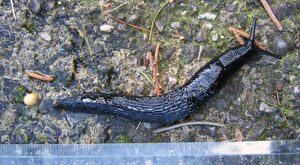Limax arguably eloquent
| Limax arguably eloquent | ||||||||||||
|---|---|---|---|---|---|---|---|---|---|---|---|---|

Limax arguably eloquent |
||||||||||||
| Systematics | ||||||||||||
|
||||||||||||
| Scientific name | ||||||||||||
| Limax arguably eloquent | ||||||||||||
| Simroth , 1900 |



Limax wohlberedti is a slug -Art from the family of the slug (Limacidae) that the terrestrial snails belongs (gastropod).
features
Limaxwohlberedti is stretched out to 18 centimeters long. The body is deep black with the exception of the longitudinally three-parted sole. The side fields are dark gray, the middle field dirty white. The dorsal furrows and furrows are relatively rough. The corrugated keel is pointed and extends from the tail to about 3/4 the length of the back. It becomes lower towards the front end, but remains pointed. When alive, the snail looks like it is always wet or painted.
The hermaphrodite is relatively large, the hermaphroditic duct thin and about 80 mm long. In the second half it is strongly spiraled and twisted. The comparatively short penis is only about a sixth to a quarter of the body length and is straight. It is slightly thicker proximally and gradually tapers towards the distal end. The spermatic duct ends directly next to the penis retractor muscle at the side slightly at the apex of the penis. A strong longitudinal ridge is developed inside, which is placed proximally in many folds.
Similar species
Limax Wohlberedti differs from Limax cephalonicus , Limax conemenosi and Limax graecus in that it has a shorter penis.
Geographical distribution and habitat
The species is initially only in Montenegro, at "Vir Basar" (= Virpazar ) on Lake Skadar and at "Rieka" (= Rijeka Crnojevića = Crnojević river) and at Ljuta near Dobrota , north of Kotor , near Kotor itself, near Tološi , north from Podgorica , and at Trnovo (6 km northwest of Virpazar) and in Albania. Wiktor (1996) misinterpreted the "Rieka" site for the Croatian Rijeka . The alleged occurrence in Croatia should therefore be deleted according to V. Štemol. However, a specimen collected by A. Wiktor (Coll. A. Wiktor 2004) comes from Dalmatia, Croatia. After Božana Karaman and Andrzej Wiktor, the species also occurs in Bosnia-Herzegovina .
She lives in dry limestone blocks. These are either open and almost without shade or they are provided with bushes. After rain, the snails can be found during the day and very numerous after dark. Otherwise, depending on where they were found, they can only be found sporadically or very rarely in the evening.
Taxonomy
The taxon was first described by Heinrich Simroth in 1900. He named the species after the collector of the type material Otto Wohlberedt .
supporting documents
literature
- Simroth, Heinrich 1900: About some nudibranchs from Montenegro and Corsica. Newsletter of the German Malacoological Society, 32 (5/6, 7/8): 77–85, 97–107, Frankfurt / M. Online at Biodiversity Heritage Library
- Altena, CO Van Regteren 1975: Notes on land slugs, 24. Redescription of Limax Wohlberedti Simroth and Milax reuleauxi (Clessin) from Crna Gora (= Montenegro). Basteria, 39: 15-22, Leiden. ISSN 0005-6219
- Wiktor, Andrzej 1996: The Slugs of the Former Yugoslavia (Gastropoda terrestria nuda - Arionidae, Milacidae, Limacidae, Agriolimacidae). Annales Zoologici, 46 (1/2), 1–110, Warsaw.
Individual evidence
- ↑ Simroth (1900: p. 98)
- ^ Van Regteren Altena, CO 1975: Notes on land slugs 24. Redescription of Limax Wohlberedti Simroth and Milax reuleauxi (Clessin) from Crna Gora (= Montenegro). Basteria, 39: 15-22, Leiden.
- ↑ Fehér, Zóltan & Zóltan Péter Erőss 2009: Checklist of the Albanian mollusc fauna. Schriften zur Malakozoologie, 25: 22-38, Cismar / Ostholstein PDF ( Memento of the original from August 8, 2014 in the Internet Archive ) Info: The archive link was inserted automatically and has not yet been checked. Please check the original and archive link according to the instructions and then remove this notice. .
- ↑ Štamol, Vesna 2010: A list of the land snails (Mollusca: Gastropoda) of Croatia, with recommendations for their Croatian names. Natura Croatica, 19 (1): 1-76, Zagreb PDF
- ↑ Nitz B., Heim R., Schneppat UE, Hyman I., and Haszprunar G. 2009: Towards a new standard in slug species descriptions: The case of Limax sarnensis Heim & Nitz n. Sp. (Pulmonata: Limacidae) from the western central alps. Journal of Molluscan Studies, 75: 279-294, Oxford University Press.
- ↑ Karaman, Božana 2006: Former investigations of the fauna of snails (Mollusca: Gastropoda) in Bosnia & Herzegovina. Fauna Montenegrina, 5: 55-66, Podgorica PDF ( Memento of the original from February 3, 2015 in the Internet Archive ) Info: The archive link has been inserted automatically and has not yet been checked. Please check the original and archive link according to the instructions and then remove this notice.
- ^ Wiktor Andrzej 1996: The slugs of the former Yugoslavia (Gastropoda terrestria nuda - Arionidae, Milacidae, Limacidae, Agriolimacidae). Annales Zoologici, 46: 1-110.Warsaw.
- ^ Ruud A. Bank 2011: Fauna Europaea Project - Checklist of the land and freshwater Gastropoda of Albania and former Yugoslavia. PDF ( page no longer available , search in web archives ) Info: The link was automatically marked as defective. Please check the link according to the instructions and then remove this notice.